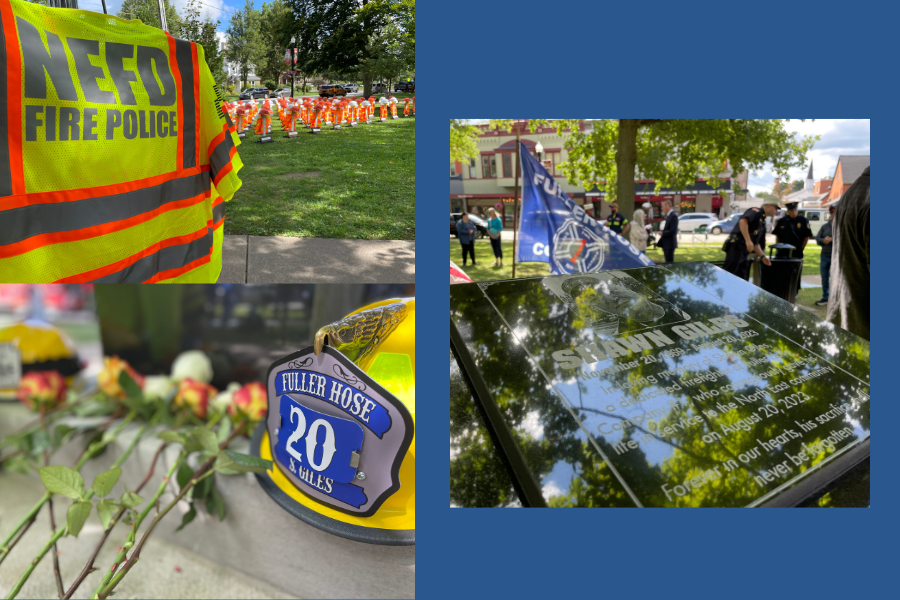On Aug. 20, the Pennsylvania Department of Transportation helped honor the life of firefighter Shawn Giles at the unveiling of a permanent memorial one year after his tragic death while responding to a roadside crash scene.
The event was organized by Adele Burnett-Giles, widow of Shawn Giles, and the Fuller Hose Company No. 1., who have become partners in advocating for Pennsylvania's Move Over Law.
“I promised Shawn his death was not going to be in vain," Burnett-Giles said. “I am going to try to do my part to make sure this senseless tragedy doesn't happen to another family."
Giles was performing fire police duties on Aug. 20, 2023, at a crash scene on Route 20 near North East in Erie County when he was struck and killed by a motorist.
On Aug. 20, 2024, more than 100 community members gathered at Gibson Park to remember the life of a fallen firefighter on the one-year anniversary of his death.
“Words cannot accurately express how much we appreciate the outpouring of love and support from the community over the past year," said Dan Adamus, Captain of the North East Fire Department Fire Police. “From fellow firefighters to countless caring people who have called, sent notes, and offered their support from all over the world."
The PennDOT Traveling Workers' Memorial was also on display during the event to honor the lives of the 90 employees killed in the line of duty since 1970 and reiterate the importance of the Move Over Law.
“Roadside workers and first responders are providing critical services to our communities. Drivers are obligated to do their part to keep everyone safe," said PennDOT District 1 Executive Brian McNulty. “PennDOT prioritizes safety above all else and will continue to conduct educational outreach to motorists to help prevent such tragic outcomes."
Pennsylvania's Move Over Law requires drivers approaching an emergency response area to move over or slow down for all responders, including police, fire, and ambulance crews, as well as stopped tow trucks and maintenance vehicles. The law also mandates drivers change lanes or slow down when approaching disabled vehicles when at least two emergency displays, such as vehicle hazard lamps, road flares, and/or cones or caution signs are present.
When merging into another lane is not possible, the law requires drivers to pass at a speed of no more than 20 miles per hour less than the posted speed limit and reasonable for safely passing the emergency response area, which is defined as any spot where an emergency vehicle has its lights flashing, or where road crews or emergency responders have lighted flares, posted signs, or try to warn travelers.
“Not only is it common courtesy to move over or slow down to give first responders ample space to do their jobs safely, it's also the law," said Trooper Todd Bingman, a Community Services Officer with PSP Troop E. “The penalties associated with failing to obey the Move Over Law are serious because lives are at risk."
Violating the Move Over Law can result in a citation carrying a fine of $500 for first-time offenders, a $1,000 fine for a second offense, and a $2,000 fine plus a 90-day license suspension for third or subsequent offenses. Additionally, penalties are increased for any incident that results in serious or fatal injuries to another person.
“Shawn's death is proof of what can happen if you do not follow the laws and posted signage when approaching an accident scene," Burnett-Giles said. “Be aware of your surroundings, don't drive distracted, don't drive under the influence of drugs or alcohol, and obey traffic laws. This all seems so easy, but here we are."
In 2023, PennDOT data shows there were 110 crashes in work zones in Pennsylvania as a result of aggressive driving, which resulted in two fatalities.
At least 158 first responders have been struck and killed in Pennsylvania attending to emergency scenes, according to data from the Emergency Responder Safety Institute.
“Any life lost on the roadway is too many and we cannot allow this trend to continue," said Austin Soboleski, a Community Traffic Safety Project Coordinator with the Highway Safety Network. “When approaching an emergency response area or work zone, drivers need to slow down and follow the instructions of traffic control devices, flaggers, or the fire police. These fundamental safety habits can help make sure all roadside workers and first responders make it home to their families at the end of the day."
Burnett-Giles plans to continue partnering with PennDOT at safety events to share her testimony with other drivers in hopes of inflicting behavioral change behind the wheel.